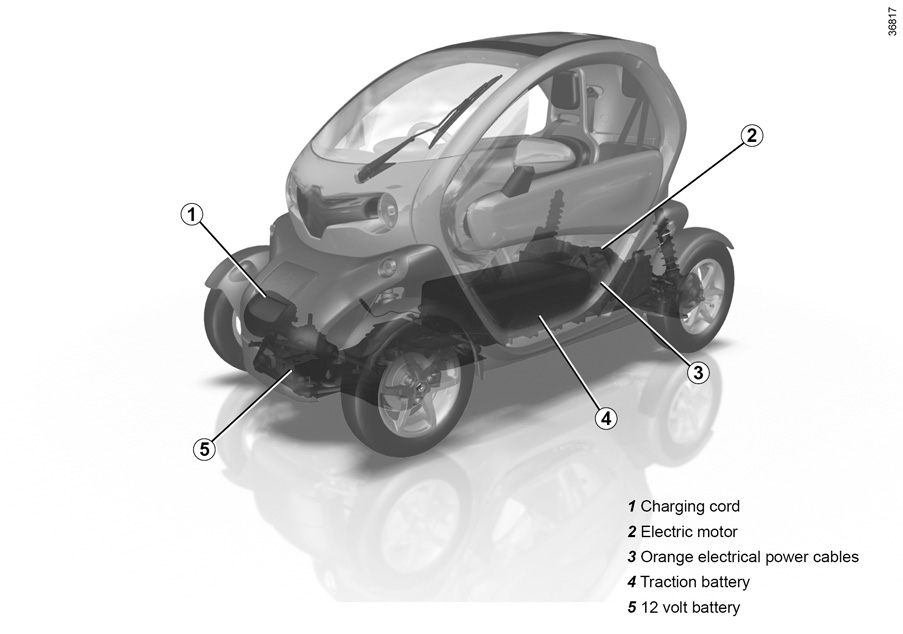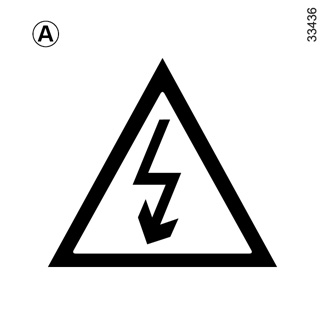ELECTRIC VEHICLE: introduction

Electric vehicles have specific features. We therefore recommend that you read these instructions describing your electric vehicle carefully.
Special feature
Depending on the country, this vehicle has been approved for the four-wheel category or for passenger vehicles. It may need to meet special regulations regarding the type of driving licence required, the type of road used, etc. Please ensure that you comply with the legislation of your country.
Batteries
Your electric vehicle has two types of battery:
- a traction battery;
- a 12 volt battery.
“58 volt” traction battery
This battery stores the energy necessary to operate the motor in your electric vehicle. As with any battery, it discharges after use, and must be regularly recharged.
You do not have to wait until the traction battery hits the reserve level in order to recharge it.
Using a domestic socket, it takes approximately 3.5 hours to complete a full charge.
Your vehicle range will depend on the charge level of the traction battery, and also on your driving style.
Please refer to information on “Vehicle range: recommendations” in Section 2.
12 volt battery
The second battery on your vehicle is a 12V battery: this supplies the energy required to operate vehicle equipment (lights, washer/wipers, etc).
The 12 V battery is charged either:
- when the traction battery is charged;
- when the ignition is on;
Please see the information under “12 volt battery” in Section 4.

The A symbol denotes the electrical elements of your vehicle which may present health risks.
“58 volt” electrical circuit
The electrical circuit can be recognised by the orange cables and by the elements signalled using the ṑ symbol.
The vehicle drive system in an electric vehicle uses a direct voltage of approximately 58 volts. This system can get hot during and after switching off the ignition.
All interventions or modifications to the vehicle’s electrical system (components, cables, connectors, traction battery) are strictly prohibited due to the risks they present to your safety. Please contact an authorised dealer.
Risk of fire, burns or electric shocks which may lead to serious injury.
Noise
Electric vehicles are particularly quiet. You will not yet necessarily be used to it, and neither will other road users. It is difficult for them to hear the vehicle when it is moving.
We would therefore recommend that you are aware of the horn and make use of it, especially when driving in a built-up area or when manoeuvring (please see the information under “Horn” in Section 1).
As the motor is silent, you will hear noises that you are not used to hearing (aerodynamic noises, tyre noise, etc.).
When charging, the vehicle may emit noises (fan, relays, etc).
Your electric vehicle is silent, so when you get out, always check that the handbrake is engaged and switch off the ignition.
Risk of serious injury.
Driving
When you lift your foot off the accelerator pedal, the motor generates electrical current during deceleration, and this energy is used to recharge the traction battery. Please refer to the information on the “Charge meter” in Section 2.
An electric motor generates a greater engine brake than in a petrol or diesel engine vehicle.
Obstructions to the driver
On the driver’s side, only use mats suitable for the vehicle, attached with the pre-fitted components, and check the fitting regularly. Do not lay one mat on top of another.
There is a risk of wedging the pedals.
For safety reasons, adapt your driving to driving conditions and avoid any sudden turning of the steering wheel, especially on steep slopes or slippery surfaces.
Failure to respect these recommendations may lead to a loss of control of the vehicle.
Risk of accident and serious injury.
Having a passenger effects vehicle balance, road holding and increases the vehicle braking distance.
Adapt your driving to the driving conditions and avoid any sudden manoeuvre which could lead to a loss of control over the vehicle. Risk of accident and serious injury.
Bad weather, flooded roads:
| Do not drive through floods if the depth of water is above the lower edge of the wheel rims. |
If a water level reaches the vehicle floor, do not recharge the vehicle. Please consult an authorised dealer.
Risk of electric shock and a risk to life.
Special cases
- At very high exterior temperatures, a safety mode is triggered. Warning light comes on the instrument panel. This mode reduces vehicle power and can lead to its immobilisation. We recommend that you stop and allow the electrical system to cool down, until the warning light goes off. The vehicle then recovers its performance.
- After a maximum charge for the traction battery and during the first few miles when driving the vehicle, or during very low outside temperatures, the engine brake is temporarily reduced. Please adapt your driving style accordingly.
The engine brake should under no circumstances be used as a substitute for the brake pedal.
